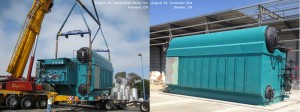California, if considered a country, is among the top 20 emitters of CO2 worldwide. Current legislation addressing GHG include California Assembly Bill 32 (AB32), aimed at reducing existing GHG emissions to 1990 levels by 2020, and the California Environmental Quality Act’s (CEQA) Climate Change Action Plan that incorporates Best Performance Standards (BPS) measures into the review process to assist new boiler permit applicants (natural gas-fired units). The policy relies on the use of BPS to assess GHG emissions on global climate change and standards are incorporated in the overall design and operation of the equipment, providing the most efficient performance measures with major reductions in GHG emissions.
Current BPS examples that provide maximum efficiency benefits include:
- ? 20ºF Approach Temperature on the Economizer
- ? 15% Excess Air with O2 Trim
- ? 10% FGR
- VFD on Fan
- Heat Recovery on Blowdown if over 8%
Nationwide Boiler recently provided a BPS boiler solution to a CA pulp and paper customer governed by the San Joaquin Valley Air Pollution Control District (SVAPCD). BPS equipment included a 75,000 pph boiler, CataStak™ SCR system, EconoStak economizer and auxiliary equipment. The system incorporates the latest boiler upgrades and once in operation, will perform well below current NOX standards.
This system is one of many BPS solutions supplied by Nationwide Boiler, and BPS boilers in operation include several prominent food processors located throughout CA. Each company is committed to operate their boiler systems with the most technologically advanced equipment in the industry, doing their part in helping the environment and lowering overall GHG emissions, while running operations as efficiently as possible.
Nationwide Boiler BPS Boiler System Delivered
For additional information regarding BPS requirements, specific to the San Joaquin Valley, visit: http://www.valleyair.org/Programs/CCAP/bps/BPS_idx.htm#Boilers



